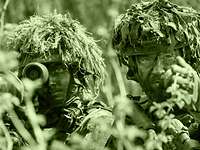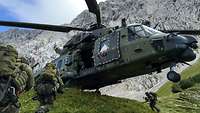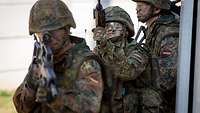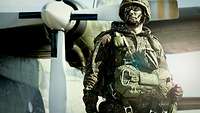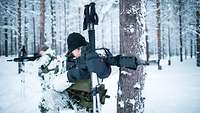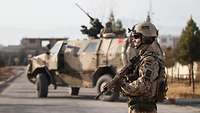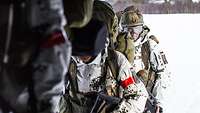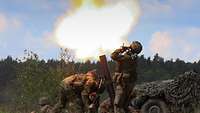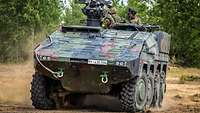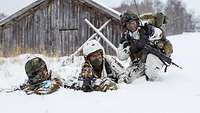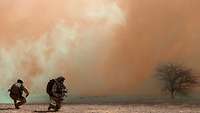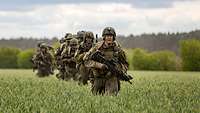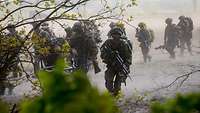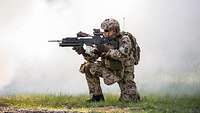The infantry fights in urban or heavily forested terrain, in the mountains, at high altitudes, under extreme climatic and weather conditions. To do so, infantry soldiers need light, modular and robust equipment. Infantry weapons must be precise, modern and effective. Using different modular elements, they can be individually adapted to the respective requirements. They are used to engage targets at short, medium and long range. The weapons employed are continuously improved by drawing on the latest technology.
The Future Infantryman System
Infanterist der Zukunft (IdZ, or Future Infantryman) describes a state-of-the-art kit for the infantry. It gives soldiers the ability carry out their tasks on foot or in vehicles with substantially improved success prospects and decreased risk. This complex set of personal equipment is intended to enhance a soldier’s effectiveness on operations, command and control capability, personal mobility, survivability and sustainability.
The IdZ programme was implemented in two steps with the independent projects IdZ-BS (basic system) and IdZ-ES (enhanced system).
To meet the requirements of the force in the field as quickly as possible, the IdZ-BS system was procured as a first step by purchasing commercial off-the-shelf components. Some individual capabilities were deliberately not provided.
IdZ-ES – a highly modular system
In a second step, the IdZ-ES system was newly developed from the ground up, as only a closed and coordinated system can fulfill all the essential capability requirements that the infantry needs to do its job. All included components were optimised in terms of weight. The complete system includes the following subsystems:
The clothing, protective and load-carrying equipment or BST subsystem is adapted to ergonomic requirements and offers flame protection, insect protection, CBRNchemical, biological, radiological, nuclear protection, and additional protection against projectiles and fragments. The multi-layered design of the clothing components is optimised in terms of climate control and breathability. That improves soldier performance.
Weapons, optics, optronics (WOO)
Among other things, a significantly lighter combat helmet with better protection, an integrated night-vision device mount, a helmet-mounted display and a digital electronic compass were introduced. The combat helmet is compatible with the in-ear radio headset/hearing protection and can also integrate over-ear hearing protection for heavy-weapons operators.
The WOO subsystem is tailored to the Bundeswehr marksmanship concept and, as it is ergonomically adapted to the BST subsystem, it ensures increased responsiveness, better protection and greater effectiveness. Increased lethality is provided by more effective weaponry, such as the improved G36 assault rifle, and supported by the improved night-combat and night-vision capabilities provided by high-resolution target optics with a larger field of vision along with night-vision attachments and adapters.
Command, control, computers, communications and information (C4I)
Command, control, computers, communications and information, C4I for short, is the IdZ system component that handles signals communications.
The equipment consists of an “electronic back” that attaches to the back of the level-4 ballistic vest. The electronic back contains a core computer, section radio, GPSGlobal Positioning System receiver and batteries. It is controlled using a control and display unit that also provides the soldier with situation updates and messages. Information can also be accessed using a display mounted to the helmet. Another component is the headset and microphone, which is connected to the section radio and also serves as hearing protection. Section leaders have additional portable command and control computers at their disposal.
What does the C4I equipment do?
By networking with each other and with higher levels of command, the capabilities of the soldiers receive an additional, significant boost. With the C4I system component, the soldiers become part of network-centric operations. The battlefield is connected to the distant operations centre. The required connections are made using the Army command and control information system, which is the digital command and control system of the land forces. That way, the soldiers in the operations centre are very quickly apprised of the current situation of the troops in combat. Decision-making is sped up and improved. Interfaces can be used to network all soldiers at section level in combat to allow them to employ C4I for tactical purposes.
Control of the C4I components is precisely in line with operational requirements. Improved ergonomics provide more ease of use and are less demanding in terms of hand-eye coordination. For instance, all of the essential tactical functions can be performed using control elements directly attached to the weapons. The IdZ-ES system is also designed to be integrated into the Puma armoured infantry fighting vehicle and the Boxer multi-role armoured vehicle, and is optimised for an employment with these vehicles.
